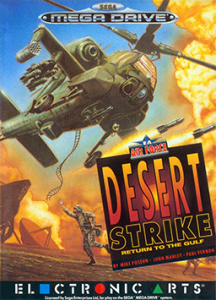427th played so far
Genre: Shoot Em Up
Platform: Various
Year of Release: 1992
Developer: Electronic Arts
Publisher: Electronic Arts
The weirdness of playing these games is how it shows our gaming options have changed over the years. Shoot Em Ups now feel like they take some effort – they don’t usually hit the right pleasure centers of my brain and it feels like it can take too much effort to just learn attack patterns.
Twenty years ago though, I had less games available to me, and shoot em ups were a large part of that group – they are incredibly common in the earlier years of the list too. I enjoyed them – and the relative variety they offered, from the static screens of Space Invaders to the side scrolling of games like Gradius and the open nature of today’s game, Desert Strike: Return to the Gulf. There was something interesting about developers exploring the limits of the genre, but just as much, it showed how we were happy with less details and more focus on the core elements.
Our Thoughts
To be honest, Desert Strike sounds almost more like an adventure when compared to those titles. While shooting and killing enemies is still a big part of the game, your goal is to rescue stranded soldiers from a desert overrun by the bad guys – the ‘Gulf’ designation making clear where they’re intended to be from.
The game has you moving over an isometric field, allowing you to attack with three different weapons (an unlimited but weak normal gun and two stronger but limited weapons, for which you can pick up ammo elsewhere). There’s plenty to destroy and a lot of enemies in your way. The controls mostly feel fairly accurate, but the lack of UI makes it difficult to see some vital facts – such as health and, more important, what weapon you currently have selected. Fuel is also limited, again with no indicator, requiring frequent returns if you don’t find any in the field, which also limits the amount of time you have to explore.
That’s certainly one annoyance, as the world is big, without many indicators of where to rescue your fellow soldiers. This means that, unless you’ve memorized the stage (or looked it up) you’re spending a lot of time aimlessly flying around, again without much indication of where you are, retreading a lot of ground. The graphics are a bit too uniform at times, adding to this – there are landmarks, but you need to happen to find them, and the circuitous route by which you get to some of them. Similarly, finding the ship you launch from is quite difficult because of the endless sea that looks the same everywhere. It makes for more of an adventure, more of a puzzle, and works for people who wanted to invest more time in it – but as said, I feel like I’ve grown past that.
Final Thoughts
There’s a lot of things that the game does surprisingly well, and I’d argue that for the most part I really enjoyed playing it. It did, however, get clunky enough in places that it’s not a game I’d put in my own rotation. It just makes me hope that we find more games like this soon, a bit more advanced, to have it play better. I’m not really aware of any, but it feels like there must have been.

[…] game almost immediately reminded us of Desert Strike. Not in full gameplay, although if you replace its 2D landscape with a 1D flat (platformer-like) […]
[…] So here we go: Return Fire looks like a military twin stick shooter from the early days not unlike Desert Strike, but with ground […]